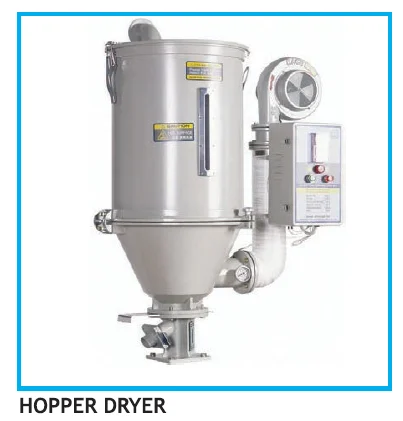As the CEO of Amige, I’ve seen firsthand the pivotal role that moisture control plays in plastic processing. Moisture can be a real game-changer, and knowing how to handle it is crucial.

So, what’s the difference between a hopper dryer and a dehumidifier? At a glance, both devices manage moisture, but their applications in the plastic processing industry are quite distinct. Let’s dive into the specifics.
Understanding the nuances of these machines is key to optimizing your production process. So, let’s break it down.
What is a Hopper Dryer and How Does It Work?
Hopper dryers are commonly used in plastic manufacturing. They are specifically designed to remove moisture from plastic pellets before processing. By using hot air to dry the pellets, hopper dryers prevent defects in the final product that can occur due to moisture.
The process involves blowing hot, dry air through the pellets, which effectively removes any moisture content. This is critical because even a small amount of moisture can affect the quality of the molded plastic.
Why is a Dehumidifier Different?
Dehumidifiers, on the other hand, are used to control the overall humidity level in the environment, rather than directly drying materials. They work by extracting moisture from the air, thus maintaining a consistent and controlled level of humidity. This is especially important in plastic processing plants where humidity levels can affect the quality of the product.
While hopper dryers target the material directly, dehumidifiers create a conducive environment for materials to remain dry or to be processed in optimal conditions.
Which One Should You Choose for Your Plastic Processing?
Choosing between a hopper dryer and a dehumidifier depends on your specific needs in the plastic processing cycle. If you’re looking to directly dry out plastic pellets before molding, a hopper dryer is your go-to.
But if you’re more concerned about maintaining a controlled humidity environment in your facility to ensure the quality of your products, then a dehumidifier is what you need.
Are There Situations Where Both Are Necessary?
In some cases, both a hopper dryer and a dehumidifier might be necessary for a plastic processing plant. For instance, if you’re operating in a region with high ambient humidity, using a dehumidifier to control the plant’s overall humidity while using hopper dryers for direct material drying could be the best strategy.
This combination ensures that both the environment and the materials are optimally prepared for high-quality plastic production.
What Are the Key Benefits of Each?
Hopper dryers provide direct and efficient drying of materials, which is essential for quality plastic products. They’re particularly useful for preventing surface imperfections and structural weaknesses in the final product.
Dehumidifiers, meanwhile, offer broader environmental control, reducing the risk of moisture-related defects and ensuring consistent production quality.
Conclusion
Whether you opt for a hopper dryer, a dehumidifier, or both, understanding their differences is key to making informed decisions for your plastic processing needs. At Amige, we’re committed to providing top-quality, customizable solutions to meet these needs. Embracing the right moisture control technology can significantly uplift the quality and efficiency of your production.
